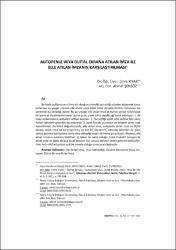Autopenle veya dijital ekrana atılan imza ile elle atılan imzanın karşılaştırılması
Citation
Kiyak, E. & Sensoz, A. (2021). Autopenle veya dijital ekrana atılan imza ile elle atılan imzanın karşılaştırılması. Süleyman Demirel Üniversitesi Hukuk Fakültesi Dergisi, 11(2), 791-838. https://doi.org/10.52273/sduhfd..966488Abstract
Bir irade açıklamasının kime ait olduğuna yönelik belirsizliği ortadan kaldırmak üzere
kullanılan en yaygın yöntem elle atılan imza (ıslak imza) olmakla birlikte, kullanılan tek
yöntemin bu olmadığı açıktır. Bu çalışmada, elle atılan imza ve bunun yerine kullanılacak
bir işaret ya da yöntemin temel olarak şu üç işleve sahip olabileceği kabul edilmiştir: 1. Bir
irade açıklamasının aidiyetini ortaya koymak. 2. (Geçerliliği yazılı şekil şartına tabi olan)
hukukî işlemlere geçerlilik kazandırmak. 3. İspat hukuku açısından bir belgeye senet vasfı
kazandırmak. Bu kabul doğrultusunda, elle atılan imza, autopenle atılan imza ve dijital
ekrana atılan imza ile karşılaştırılmış ve her bir yöntemin, yukarıda belirtilen üç işlevi
yerine getirme kabiliyetine sahip olup olmadığı tespit edilmeye çalışılmıştır. Böylece, elle
atılan imzanın yukarıda belirtilen üç işleve de sahip olduğu, buna mukabil autopen ile
atılan imza ve dijital ekrana atılan imzanın söz konusu işlevleri yerine getirme kabiliyetlerinin ise kısıtlı/tartışmaya açık bir mesele olduğu sonucuna ulaşılmıştır Although a handwritten signature is the most commonly used method to
eliminate ambiguity about to whom a declaration of intention belongs to, it is clear
that this is not the only method used. In this study, it is accepted that a handwritten
signature and a sign or method to be used as its substitution can basically have the
following three functions: 1. to reveal the belonging of a declaration of intention, 2. to
give validity to legal transactions (whose validity is subject to the condition of the
written form), and 3. to give a document the deed qualification in terms of evidence
law. In line with this acceptance, the handwritten signature was compared with the
signature made with autopen and the (handwritten) signature on the digital screen,
and it was tried to determine whether each method is capable of fulfilling the three
functions mentioned above. Thus, it was concluded that the handwritten signature has
all three functions mentioned above, whereas the ability of the signature with autopen
and the signature on the digital screen to fulfill these functions is limited/controversial.


















